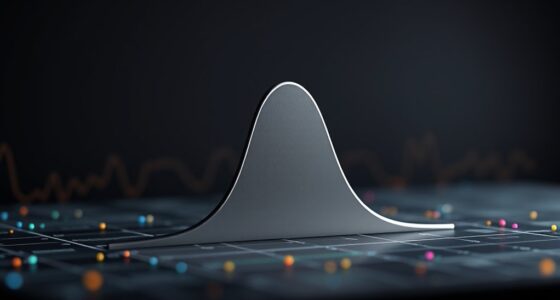Skewness and kurtosis are essential tools for understanding your data’s shape. Skewness shows if your data leans to one side, indicating asymmetry, while kurtosis reveals how heavy or light the tails are, pointing to the likelihood of extreme values. Knowing these helps you interpret patterns beyond averages and spreads, especially in fields like finance and quality control. Keep exploring to uncover more about what these measures tell you about your data’s true nature.
Key Takeaways
- Skewness measures data asymmetry; positive skew indicates a longer right tail, negative skew a longer left tail.
- Kurtosis describes tail heaviness; high kurtosis means more extreme outliers, low kurtosis fewer outliers.
- Understanding skewness helps identify whether data leans toward higher or lower values.
- Kurtosis reveals the likelihood of encountering extreme values or outliers in the dataset.
- Both metrics provide deeper insights into data distribution shape beyond mean and variance.

Understanding skewness and kurtosis is essential for analyzing the shape of data distributions. When you look at a set of data, you’re interested not just in the average or spread but also in how the data points are arranged around that average. This arrangement—called the distribution shape—reveals patterns that can inform your understanding of the underlying process. Skewness and kurtosis are two statistical measures that help you quantify these patterns, especially the aspects related to symmetry and tail behavior.
Skewness measures the degree of asymmetry in your data’s distribution. If your data is perfectly symmetrical, the distribution has no skewness, meaning the left and right sides mirror each other. When skewness is positive, the tail on the right side is longer or fatter, indicating more extreme high values. Conversely, a negative skewness means the tail on the left side extends further, suggesting more extreme low values. Recognizing these patterns allows you to understand whether your data leans toward higher or lower values, which can be critical in fields like finance or quality control. For example, a positively skewed income distribution indicates a majority earning below the average, with a few high earners pulling the mean upward.
Kurtosis, on the other hand, describes the heaviness of the tails in your data’s distribution. Think of kurtosis as a way to measure how outliers or extreme values are distributed. A distribution with low kurtosis, called platykurtic, has lighter tails and fewer extreme outliers. High kurtosis, or leptokurtic, indicates heavier tails, meaning more outliers than you’d expect in a normal distribution. When kurtosis is close to that of a normal distribution, your data is considered mesokurtic, which suggests a typical distribution with moderate tails. Understanding kurtosis helps you grasp the likelihood of encountering extreme values, which is essential in risk assessment, financial modeling, or quality assurance. Additionally, current news in Indonesia can impact data patterns, influencing statistical analyses in various sectors.
Frequently Asked Questions
How Do Skewness and Kurtosis Affect Data Interpretation?
When you analyze data, understanding how skewness and kurtosis affect interpretation is key. They reveal the distribution shape, showing if outliers influence your data or if it’s symmetrical. Skewness indicates asymmetry, while kurtosis shows the presence of extreme outliers. Recognizing these helps you assess data reliability, identify potential biases, and make informed decisions, ensuring you don’t overlook outlier influence or misinterpret the distribution shape.
Can Skewness and Kurtosis Be Used Together for Better Analysis?
You can definitely use skewness and kurtosis together for better analysis, especially in joint distribution and multivariate analysis. By examining both, you gain a clearer picture of data shape and tail behavior across multiple variables. This combined approach helps you identify asymmetries and outliers more effectively, leading to more accurate insights and predictions. As a result, your analysis becomes more robust and nuanced, improving decision-making and model performance.
What Are Common Pitfalls in Calculating Skewness and Kurtosis?
Think of calculating skewness and kurtosis as walking a tightrope; one misstep can lead to skewed results. Common pitfalls include ignoring outliers influence, which can distort your measurements, and improper normalization, causing inconsistent comparisons. Always clean your data and use correct formulas. If you overlook these issues, your analysis might be misleading, making it seem like your data’s story is different from reality.
Are There Specific Data Distributions That Always Have High Kurtosis?
Certain distribution types, like heavy-tailed or leptokurtic distributions, always have high kurtosis because they naturally produce more outliers, which inflate kurtosis measures. If your data comes from distributions with frequent extreme values, the outlier impact increases, leading to consistently high kurtosis. Recognizing these distribution types helps you interpret kurtosis correctly, knowing that their inherent characteristics cause naturally higher kurtosis values.
How Sensitive Are Skewness and Kurtosis to Sample Size?
Think of skewness and kurtosis as delicate sculptures, easily influenced by sample size sensitivity. When your sample is small, these measures can fluctuate wildly, making the distribution impact appear more dramatic than it truly is. Larger samples provide more stable estimates, reducing variability. So, yes, these metrics are quite sensitive to sample size, especially in smaller datasets, which can distort your understanding of the underlying distribution.
Conclusion
Now that you’ve uncovered the secrets of skewness and kurtosis, you see how they shape your data’s story. Like the twists and turns of a winding road, these measures reveal whether your data leans left or right and how sharply it peaks. Embrace their rhythm, and you’ll master the dance of distributions with confidence. After all, understanding these traits turns chaos into clarity—unlocking the true narrative behind every dataset you encounter.










